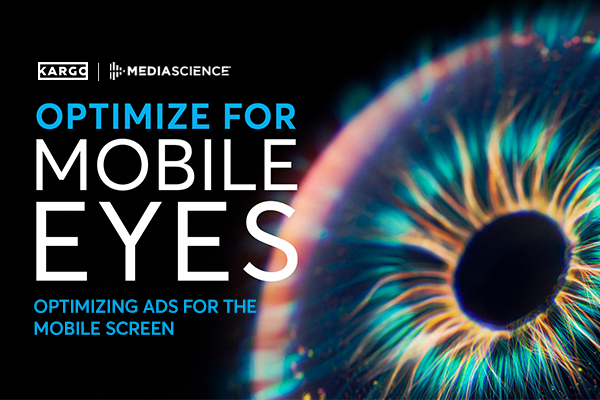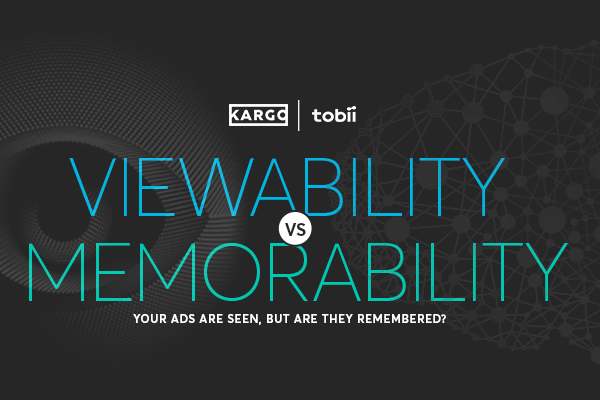Mobile Creative
There are many factors to consider when looking to build big, powerful ads... For a much smaller screen.
For marketers looking to advertise on mobile, there are many questions that arise: Can I simply utilize existing digital and print assets for mobile? Should I run a video mobile ad? How long should I make the video? How do I create a less intrusive ad experience? What sort of mobile creative would resonate best with my customer base? How do I breakthrough on the smaller screen?
Mobile ads have historically been given a bad rap, primarily due to poor execution. However, with users today consuming more digital content on their mobile phones than any other platform, including TV and desktop, mobile has become one of the fastest growing platforms for advertising. As specialists in the mobile space, Kargo’s Design Studio experts are here to provide best practices for mobile creative in order to deliver the best user experience.
Mobile creative... When it works, it works REALLY well.
The digital advertising world has come a long way. Gone are the days of basic banners, 60 second videos, autostart audio, lack of design quality, and let’s not forget the infamous, intrusive, “pop-up” ads. Not only do users respond poorly to such ad experiences, but many premium publishers today actually restrict the use of these types of ad formats.
Today’s 3 billion global smartphone users are consuming 70% of web browsing activity on mobile, making mobile the number one screen in time spent, officially bypassing TV in 2019. Following suit, marketers today are putting greater emphasis on mobile advertising. According to eMarketer, global mobile ad spend for 2019 is estimated at $240B, roughly 73% of total global digital ad spend. Mobile has consistently grown in strength year over year, with eMarketer estimating that mobile is expected to grow yet another 19% for 2020.
So with all this growing emphasis on mobile, why the bad rap? Mobile ads have evolved substantially over the years, yet many users today claim that their mobile ad clicks are accidental, that mobile ads disrupt their mobile experience, or that mobile ads obscure content. However, when executed correctly, with the right partners and employing mobile best practices, this does not have to be the case. According to a study conducted by Celtra and OnDevice Research, the top 20% of mobile ads in terms of ad recall record an average uplift between the exposed and control group of +20% points. Still not convinced? Similarly, among the best performing 20% of mobile ads, purchase intent is six times more effective than the remaining 80%.
It’s clear the question isn’t whether or not mobile works, but rather what steps advertisers should take to ensure their ads are part of that best performing 20%.
What Makes Mobile Different From Desktop?
Many of you are probably wondering what makes mobile special, or why your mobile creative needs to be managed differently from your traditional digital campaign?
Other than the obvious variance in screen size, there are other distinct differences in user behavior on mobile vs desktop that need to be considered in order to effectively execute advertising campaigns on mobile:
Mobile web visits are steadily on the rise. According to Perficient Digital, in 2018, roughly 58% of all online browsing traffic came from a mobile device, with mobile accounting for 42% of total time spent online.
Mobile web user experiences are improving.
Users are becoming more accustomed to surfing the web on their mobile devices.
Equally important to note, however, is the “on the go” nature of the mobile device, meaning users are often consuming content while in transit or quickly researching, or responding to something, resulting in mobile users spending less time on websites and mobile generating a higher bounce rate with generally less page views per session than desktop.
Think about how many times you have pulled out your phone to quickly price check something, read a review, or look something up. Once you’ve found the information you were looking for, odds are you then promptly close out the web browser and carry on with whatever it was you were doing.
While this should come as no surprise, this represents a unique challenge for advertisers as it means a significantly smaller window to capture the attention of your audience. Humanizing the brand experience to garner attention and leave a lasting impression using the basic elements of design, innovation, and creativity is key to achieving mobile marketing success.
What Creates A Great Mobile Ad?
Mobile Design is an art like any other.
With nearly half of mobile users glued to their phones for 5+ hours a day, the small screen is a big tool for brands looking to make an impact. But it comes with its challenges.
There’s the size, of course, but also the ease with which a user can skip a video or leave a page with a single scroll, swipe, or tap. Mobile ad design has to work much harder to grab eyes, stop thumbs and win attention. And as we all have seen, a lot of mobile ads aren’t taking design seriously.
From our earliest days, Kargo has led with design. We believe big, bold, eye-catching creative makes even the fastest scrollers stop, lean in and engage with an ad. To that end, we’ve arrived at a set of tried and true best design practices to keep in mind as you prep your next campaign:
Non-Intrusive Formats
Focus on creating ads that captivate the consumer without taking them away from their content experience. A great ad unit blends seamlessly into the content that users are actively engaged with while capturing their attention. None of us like those ads that pop up over content and play games trying to find the [X] close button to get it out of the way.
Maximizing Interactivity
The biggest "hotspots", or areas seeing the most interaction on a mobile device, are in the middle or towards the bottom of the screen. Primary functions, such as swiping through a product carousel should be kept near the middle of the screen. While secondary functions, such as tapping a call-to-action, should be kept near the bottom. The ultimate goal is to ensure users are able to easily interact with the unit without frustration.
Succinct Messaging
It’s true, a picture is worth 1,000 words. Let your image do the talking, so you can keep the copy short, sweet, and to the point. That means stick to one message, because remember you only have a brief moment to capture and hold the attention of a user as they scroll by.
Reduce Clutter
Less is more, white space can guide the eye to a key product or benefit better than a crowded backdrop.
“Snackable” Animations & Video
The average attention span is 6 seconds or less. Make every one of those seconds count by creating thumb-stopping ads with clear messaging, beautiful creative, and strong design.
Logo Presence
Perhaps a bit obvious, but an often overlooked principle in mobile creative design is logo presence. As previously mentioned, you’ll likely only have a brief window to capture the attention of your audience. Whether users see your ad for half a second or ten, you want to be sure they know the ad is for your brand.
Logo Placement
Logo placement is also key. Users are more likely to notice a logo when it is placed at the top of the ad. When advertisers are looking to ensure ad recall, just remember that top of creative means top of mind.
Product Centric
Another obvious but overlooked principle is having your product featured front and center within the ad. This is especially true when you’re looking to drive purchase intent. When users see your ad, you want to ensure that there is no doubt as to what it is they are buying.
Singular Branding
While it’s tempting to have logos for products and a logo for your brand, you want to avoid “logo soup”, a situation that leaves a user unsure which brand was behind the ad. Avoid dual branding, multiple logos, or assets that distract or confuse.
Call to Action
You’ve captured your audience's attention with your clear messaging and excellent mobile creative, now you want to invoke an action. Having a prominent and clear call to action (CTA) is the answer. Providing a place for them to click to “buy now” or “learn more” ensures they know how to respond to your offering.
Animation & Interactivity
Gone are the days of basic display advertisements. If you want to hold your users’ attention, animation and interactivity are key. This is not limited to gamification. Having interactive ads, or scroll reactive ads is a great way to capture and hold your audience's attention. Interactive elements are playful, fun, and in a world where seconds count they can significantly boost your ad’s performance.
Humor
Invoking some sort of emotional response from your audience is a great way to grab their attention and improve ad recall. What better way to do this than with a little bit of humor? Not only do your ads become relatable, but consumers also find them more enjoyable.
Beautiful Imagery
With text-heavy articles and the quick-scrolling nature of the mobile device, users are more likely to notice a beautiful, bold image versus an ad full of lengthy text. This visual stimulation acts as a contrast against the site content – allowing the imagery to tell the brand story.
While our industry tends to obsess over data as the key to getting messages to land, it’s design that really nails that landing. Reaching the right person at the right time with a poorly designed ad doesn’t add up to the right results. It’s a well designed ad that catches the eye, sparks an emotion and makes a connection that raises awareness or closes a sale. And don’t we all want that?
What Creates A Great Mobile Video Ad
Video brings your brand to life and is a powerful tool for building awareness. Through visuals, sound and motion, it provides marketers with the ability to tell a story in a way a banner ad simply can’t achieve. That being said, videos are only effective if the target audience actually takes the time to watch it. Simply taking your TV spot and running it on mobile doesn’t do the trick. Screen ratios, audio options, interactivity and more make mobile video it’s own medium. Below are best practices for creating video ads for mobile:
Avoid Dark Backgrounds
Dark backgrounds can cause poor viewability and ultimately the performance of your ad will suffer. Keep in mind that the video will be viewed on a mobile screen, if a user cannot clearly view your content, more often than not, they will keep scrolling.
Logo Presence
This one may be redundant, but is still important even to video formats. Making your logo clearly visible aids in brand recall and recognition. Ideally you’d want your logo to appear in every frame, however if that’s not feasible, at the very least your logo should be on screen at the beginning and end of the video.
Clear Call to Action
We mentioned this in our best practices, but it’s worth mentioning again to assure your video’s success. A prominent and clear call to action encourages deeper audience engagement and, of course, makes it easy for users to act on your message. Keep in mind that the CTA must be specific to the desired action. Don’t be afraid to test different CTAs to improve click-through rates.
Engage Users quickly
Keep in mind that on the mobile screen, there are a number of different pieces of content that are all fighting for a user’s attention at the same time. Your goal is to capture their attention as quickly as possible. That’s why it’s best to open with a demonstration of your product or service, use humor, tell a story, make the content relatable, and stick to one simple message so the ad is easy to follow.
Sound
You may be convinced that the audio drives your brand's narrative, or will resonate with your audience emotionally. The truth is, most people view video ads on mobile with the sound off; having the audio optional creates a less intrusive experience. This doesn’t mean refrain from sound completely, just keep in mind that it shouldn’t be the linchpin of the ad’s narrative. Captions are the best workaround for assuring you can get your story across when it’s viewed with sound off.
Video quality
This should go without saying, but utilize high quality, high resolution video. Remember, the video is reflective of your brand. Avoid grainy, blurry, or poor quality images. If you use sound, make sure it's clear and easy to understand.
Stand out from the crowd
By the end of today, you will have been served about 300 mobile ads. You were served about 300 yesterday too. If I asked you to name the brands that served an ad to you, would you be able to? Probably not, and you wouldn’t be alone.
Fragmentation of the media landscape has created a rift in consumers' consumption habits -- where consumers' attention is no longer owed but in fact must be earned. In today's attention economy, it takes nothing short of "thumb-stopping" creative to garner recognition and appreciation.
Coupling specialized supply with creative science, Kargo campaigns aren’t just viewable, but in fact, more memorable. Using advertisers’ basic assets, Kargo’s award-winning design team turns them into beautiful mobile-first creative ads that have proven to achieve outcomes for brands with lift in awareness, engagement, visitation, store visits and ROAS. Compared to standard banners, Kargo’s mobile-optimized creatives are seen by 70% more people, are viewed 2x longer, and can be built direct or programmatically free of charge.
Are you leveraging the power of design in unique ways in order to successfully stand out from the crowd?
Reach out today to consult with a Kargo Design Studio expert and learn how you can start optimizing your mobile creative!
Suggested Articles
Related Blog Posts:






